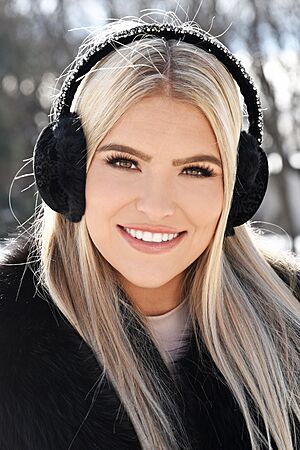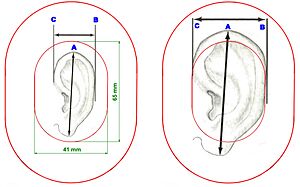Earmuffs facts for kids
Earmuffs are items that cover your ears. They usually have a band that goes over your head and soft cups that fit over each ear. Earmuffs can be used for two main reasons: to keep your ears warm in cold weather, or to protect your hearing from loud noises.
Earmuffs for Cold Weather
Earmuffs are great for keeping your ears cozy when it's chilly outside. Your ears can get cold very quickly because they stick out and don't have much muscle. Sometimes, your ears might feel cold even if the rest of your body is warm.
Who Invented Warm Earmuffs?
A young boy named Chester Greenwood from Farmington, Maine invented warm earmuffs in 1873. He was only 15 years old! He got the idea while ice skating because his ears were freezing. He asked his grandmother to sew soft fur onto wire loops. Chester then patented his idea and made earmuffs for almost 60 years in his hometown.
Why Choose Earmuffs Over Hats?
Sometimes, a winter hat can make your whole head too hot, especially if you are running around or playing. Earmuffs only warm your ears. This helps you stay comfortable without getting too sweaty. They are perfect for keeping just your ears warm on a windy or cold day.
Different Kinds of Warm Earmuffs
There are two main styles of earmuffs for cold weather. One kind looks a lot like big headphones, with a band that goes over the top of your head. Another type has two round ear covers that are connected by a band that goes around the back of your head, not over the top. Some wide headbands can also be called earmuffs if they are used to warm your ears.
Earmuffs for Hearing Protection
Hearing protection earmuffs are designed to block out loud sounds. They have special padding inside the cups that absorbs sound waves. This helps keep your ears safe from damage.
How Hearing Protection Earmuffs Started
People believe that earmuffs for hearing protection first appeared during World War II. Pilots wore leather flaps over their ears to protect them from loud airplane engine noise. Later, better versions were made with headbands and cups. In 1954, a more comfortable design with soft cushions was created.
Why Protect Your Hearing?
Loud noises can hurt your ears and cause permanent hearing loss. This means you might have trouble hearing sounds or understanding speech. Sometimes, loud noises can also cause Tinnitus, which is a ringing or buzzing sound in your ears that doesn't go away. There is no cure for tinnitus.
Organizations like the Occupational Safety and Health Administration (OSHA) in the United States recommend using hearing protection when sounds are too loud. For example, if you are around noise that is 85 dB or more for a long time, you should protect your ears. Any noise louder than 140 dB can cause instant, permanent hearing loss.
Earmuffs are great for loud activities like:
- Using power tools
- Mowing the lawn
- Going to concerts
- Shooting firearms (guns)
When using firearms, which can be very loud (140 dB to 175 dB), it's best to use both earmuffs and earplugs together. This is called "dual hearing protection."
Here's a simple guide from the National Institute for Occupational Safety and Health (NIOSH) on how long you can be around certain noise levels without protection:
| Level of noise (dB A) | Maximum daily exposure time |
|---|---|
| 85 | 8 hours |
| 91 | 2 hours |
| 97 | 30 minutes |
| 103 | 7 minutes |
How Earmuffs Reduce Noise
Earmuffs work by absorbing sound waves. They are usually made with a hard plastic outer shell and a special foam inside. This foam makes it harder for sound waves to travel through, turning their energy into a tiny bit of heat instead.
The amount of noise an earmuff can block is called its Noise Reduction Rating (NRR). This number tells you how many decibels the earmuff can reduce the sound by. For example, an earmuff with an NRR of 23 dB will make a 100 dB sound feel like 77 dB.
Passive vs. Active Earmuffs
There are two main types of hearing protection earmuffs:
- Passive Earmuffs: These are the most common type. They block sound simply because of the materials they are made from, like thick foam and hard plastic. They don't have any electronics.
- Active Earmuffs: These earmuffs have electronics and microphones. They can do cool things like:
* Allow communication: Some active earmuffs let you hear important sounds like voices or machinery while still blocking out dangerous loud noises. You can often control the volume of these sounds. * Active Noise Reduction (ANR): These earmuffs actively cancel out low-frequency noise, like the rumble of a diesel engine. They do this by creating an opposite sound wave that "cancels" the unwanted noise.
Using Earmuffs and Earplugs Together
For extremely loud places (over 103 dB), it's best to use both earmuffs and earplugs. This is called dual hearing protection. It gives you extra safety.
When you use both, the total noise reduction isn't just adding the two NRR numbers together. Instead, you add 5 dB to the higher NRR of the two devices. For example, if your earplugs have an NRR of 25 dB and your earmuffs have an NRR of 20 dB, your combined protection would be about 30 dB (25 dB + 5 dB).
Making Sure Earmuffs Work Well
For earmuffs to protect your hearing properly, they need to fit well.
Good Fit is Key
- Earmuffs should make a good seal around your ears and cover them completely.
- The headband should be the right length to hold the cups firmly over your ears.
- If you have long hair, pull it back so it doesn't get under the earmuff cushions.
- Wearing glasses with thick frames can sometimes create small gaps, letting more sound in.
If earmuffs don't fit well, they might be uncomfortable. This could make you not want to wear them, which means your ears won't be protected. Look for earmuffs that are lightweight, have soft cushions, and are easy to clean.
Check for Wear and Tear
Earmuffs can wear out over time. You should regularly check them for:
- Cracks in the plastic
- Changes in the shape or firmness of the cushions
- A loose headband that doesn't hold the cups tightly
If you use your earmuffs often, the ear cushions should be replaced every 6 to 8 months. If you use them very frequently, replace them every 3 to 4 months. Worn-out earmuffs won't protect your hearing as well.
Challenges of Wearing Earmuffs
While earmuffs are great for protection, they can make it harder to hear people talking. Speech might sound muffled. They can also make it harder to tell where sounds are coming from.
Earmuffs for People with Hearing Loss
Workers who already have some hearing loss still need to protect their ears in noisy places. It's important for them to find earmuffs that are comfortable and allow them to hear important sounds like alarms or co-workers' voices.
Sometimes, people with hearing loss might want to wear their hearing aids under earmuffs. Usually, it's not recommended to wear hearing aids in very noisy areas. However, sometimes a safety expert might allow it if it's carefully managed. Hearing aids themselves are not designed to protect hearing from loud noises.
There are special devices that combine hearing protection with communication help. These can block loud sounds but also make quieter sounds, like speech, easier to hear. This can be very helpful for people with hearing loss who need to communicate safely in noisy environments.
See also
 In Spanish: Orejeras para niños
In Spanish: Orejeras para niños
- Headphones
- Earplugs
- Muffs
- Noise-induced hearing loss
- Noise pollution
- Personal protective equipment
- Hearing protection fit testing
- Dielectric
- National Institute for Occupational Safety and Health








